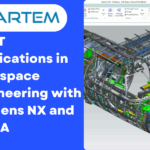Unleashing Efficiency: Siemens NX CAD Workflow Optimization for Graduate Students
Welcome, aspiring engineers and graduate students! As you delve into the intricate world of Computer-Aided Design (CAD), mastering tools like Siemens NX can be a game-changer. Today, let’s unravel the secrets of NX CAD workflow optimization, a journey that promises not just efficiency but a heightened level of productivity in your design endeavors.
Understanding the NX CAD Ecosystem
Before we dive into optimization strategies, let’s briefly explore what makes Siemens NX a powerhouse in the CAD realm. NX offers a comprehensive suite of tools for 3D modeling, simulation, and manufacturing. It’s renowned for its parametric design capabilities, advanced simulation tools, and seamless integration across various stages of the product development lifecycle.
The Quest for Optimization
1. Mastering Parametric Design:
Siemens NX thrives on parametric modeling, where relationships between elements are defined. Embrace the power of design intent by leveraging parameters, constraints, and equations. Establishing a robust parametric foundation not only ensures design flexibility but also expedites modifications when your project evolves.
2. Harnessing Synchronous Technology:
NX’s Synchronous Technology is a game-changer. This feature allows for direct editing of 3D models without the need for a history tree. Learn to leverage this tool for quick design changes, reducing the need to backtrack through a sequence of operations. It’s the key to nimble and adaptive design practices.
3. Effective Use of Assemblies:
As your projects grow in complexity, mastering assembly design becomes paramount. NX excels in this arena. Learn to use intelligent components, constraints, and motion simulation to optimize your assembly workflow. This ensures efficient collaboration and streamlines the integration of various components into a cohesive product.
4. Utilizing Design Features and Templates:
Design features and templates in NX are your productivity allies. Create reusable templates for standard components or assemblies, saving time on repetitive tasks. Understand how to use design features to encapsulate design intent and simplify the creation of complex geometries.
5. Simulation-Driven Design:
Siemens NX offers robust simulation tools. Integrate simulation early in your design process to identify potential issues and iterate swiftly. By adopting a simulation-driven design approach, you not only optimize your workflow but also enhance the overall quality of your designs.
6. The Path to Peak Productivity
Optimizing your NX CAD workflow is not just about mastering tools; it’s a mindset. As a graduate student, the skills you cultivate now will shape your future endeavors. Embrace continuous learning, explore advanced features, and connect with the vibrant community of NX users.
Remember, the key to productivity lies in efficiency, adaptability, and a willingness to explore the vast capabilities of Siemens NX. So, go ahead, unleash your creativity, and let Siemens NX be the canvas for your engineering masterpieces. The world of optimized CAD workflows awaits your innovative touch!





